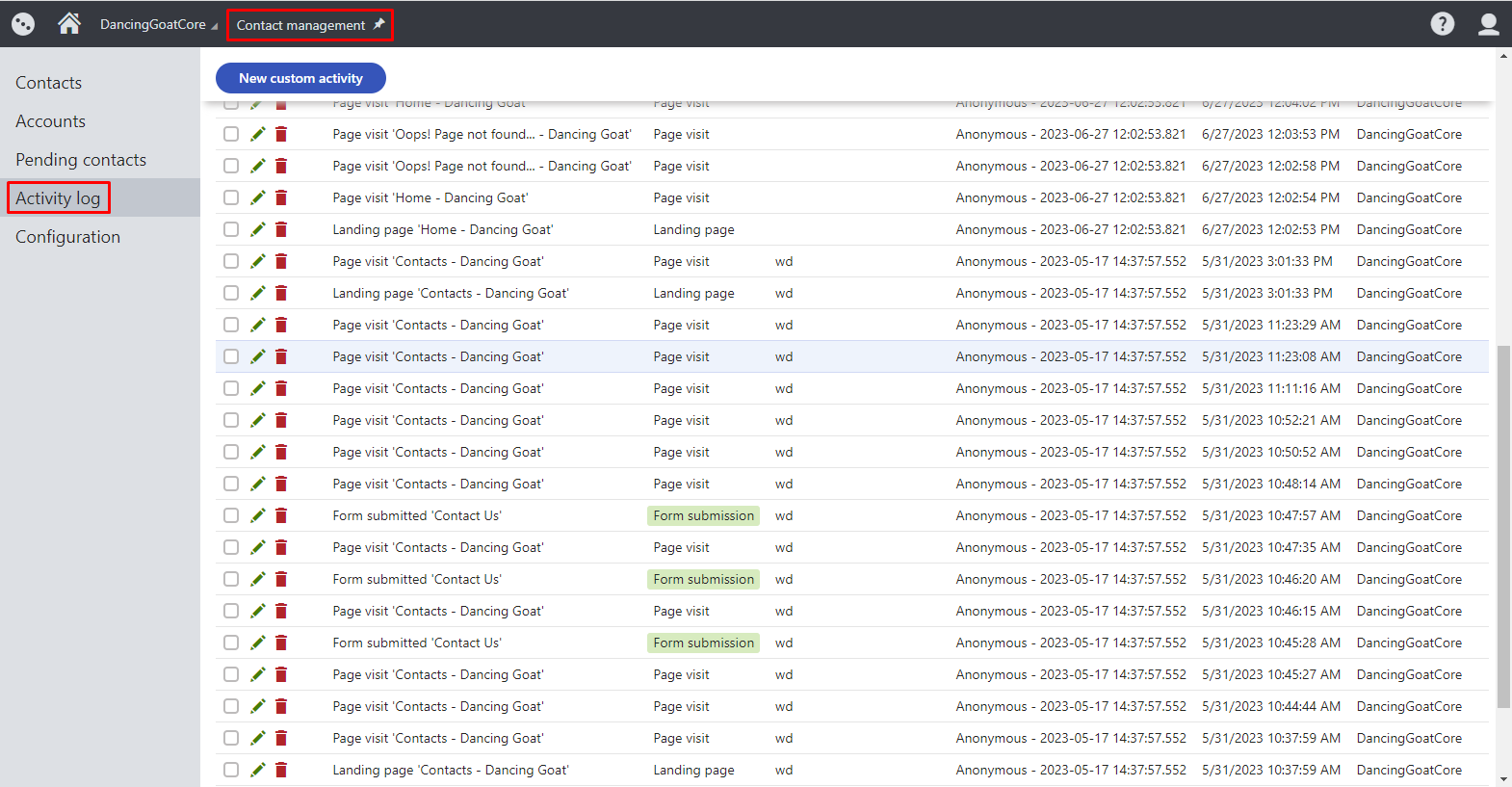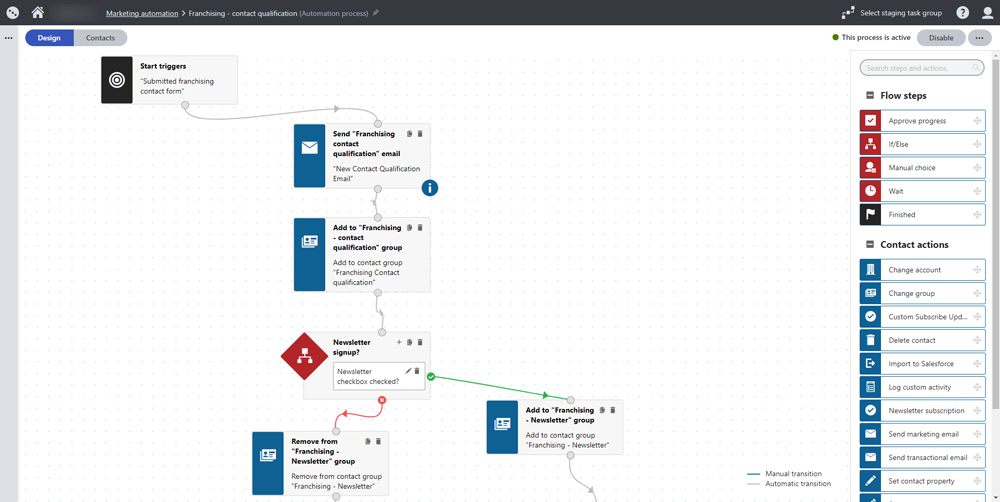
We will take you on a journey through a real-life scenario of implementing advanced tracking and analytics using Kentico Xperience 13 DXP.
Data is the modern-day gold, and without detailed tracking from the very beginning, you risk missing out on valuable insights. Only building a solid foundation of data collection ensures all your marketing efforts, like segmentation, automation, and personalization, can reach their full potential in the future.
While Kentico Xperience 13 and other DXPs offer default activity tracking, it's not enough to fully comprehend the business context of your website. Injecting context into the tracked activities becomes your responsibility to gain deeper insights into visitor interactions.
With the enabled default activity tracking Kentico Xperience tracks multiple activity types automatically, such as:
There is a common pattern here - the context of the visited page is missing.
To explain this in more detail, let's have a look at a real-life scenario we implemented recently with Kentico Xperience 13:

Page visits offer more than just a measure of visitor traffic. Understanding which specific pages users engage with can provide valuable insights into their interests, in our case, such as property type, location, price range, and status. Augmenting page visits with this additional information enriches your tracking data, leading to more informed decisions.
In our example, landing on property details page reveals:
From the search results page we could gather very similar insights:
Ideally, all this valuable information should be tracked in addition to a page visit activity.

Collecting data is only the first step, but making it actionable is where the real value lies. To achieve effective marketing automation, the activity data must be captured within your DXP. However, if your primary focus is reporting on the data and then applying actions manually, platforms like Google Analytics may suffice.
Below are the examples of reports that business could be interested in our example. These reports can be achieved in either of systems - Kentico Xperience or Google Analytics:
However later it can evolve into something more sophisticated, improving the visitor's experience based on the analytics. Supporting these cases would be easier if the analytical data is stored in the DXP:

Now we have a list of additional data to be tracked. Shall we go ahead and implement it? Not precisely. Although the data makes perfect sense now, there are multiple ways we can achieve these tracking requirements.
Before diving into implementing additional tracking information, it's essential to consider your website personas. By tailoring the tracking to individual personas, such as purchasers, landlords, renters, and vendors from our example, you can capture relevant data that aligns with their unique behavior. This targeted approach enhances user experience and optimizes marketing efforts. From our example the main personas and their typical journeys were:
1. Sally, the purchaser. Is looking to buy a new property. Typically they would:
- Visits bying landing page
- Performs a few searches for properties for sale, providing their region, price range, type and size of the property
- Visits a number of property pages for sale
- Submits arrange a viewing form for the most interesting properties
- Adds those into favourites
2. Mike, the landlord. Is looking to let his property:
- Submits request a valuation (to rent) form
- Searches for already let properties in the past, to check how efficient estate agents are in the area they live
- Visits letting landing page
3. John, the renter. Is looking to rent a property:
- Performs a few searches for the properties to rent, providing their region, price range, type and size of the property
- Visits a number of property pages to rent
- Submits arrange a viewing form for the most interesting properties
- Visits rentals landing page
4. James, the vendor. Is looking to sell a property, and then potentially buy or rent another:
- Submits request a valuation (for sale) form
- Searches for already sold properties in the past, to check how efficient estate agents are in the area they live
- Visits selling landing pages
- Downloads terms and fees documents
5. Lisa, the franchisee prospect. Is looking to invest into opening a new branch:
- Visits franchising blog
- Subscribes to franchising newsletter
- Fills franchising contact form

The list above is a starting point of custom activities we want to track and here is what can be customized when a new custom activity type is created in Kentico Xperience 13 (or Xperience by Kentico):
In a nutshell we have one string unique identifier, two integer ID fields, and two free text fields where we can store any relevant info regarding tracked activities. Next is to define how many custom activity types we need, and what additional information is written in the rest of the fields.
There are two extremes in modeling data for custom activity types:
Very often, if not always, these extreme approaches are not great, and we need to find some sweet spot in the middle.

The rule of thumb here: keep the number of custom activity types manageable - between 10 and 25. Usually, you can park between these two numbers if you create a custom activity type for each combination of your main taxonomy comprising personas and a list of actions to be tracked.
In our estate agency example:
As a result there will be 12 unique activity types, like: selling property page visit, letting property page visit, selling property search, letting property search, and so on.
One small but important detail worth noting here is that we could have avoided creating duplicates for both selling and letting in our example and stored selling or letting value in the details of the activity. However, this would have made the use of these activities inside other marketing features, like persona scoring rules or marketing automation, more complicated and less visual.
For example, when configuring persona scoring rules for a purchaser, we could either:
The second option is less attractive because:

Although custom activity gives you only 4 fields to fill, there are ways to inject more valuable context information.

Mastering advanced tracking and analytics is essential for gaining valuable insights into user behavior and optimizing marketing efforts.
By going beyond out-of-the-box tracking, understanding user interests with page visits, making analytics actionable, planning personas, crafting an ideal data structure, and attaching as much context as needed, you can create a comprehensive and effective tracking strategy for your website. Stay tuned for more insights in the next blog post in this series!

Our Solution Architect has the status of Kentico Xperience Most Valuable Professional (MVP).
